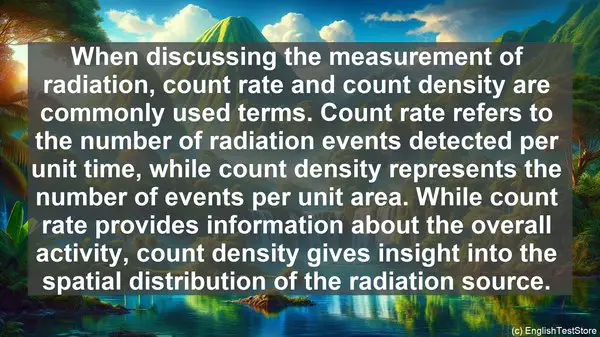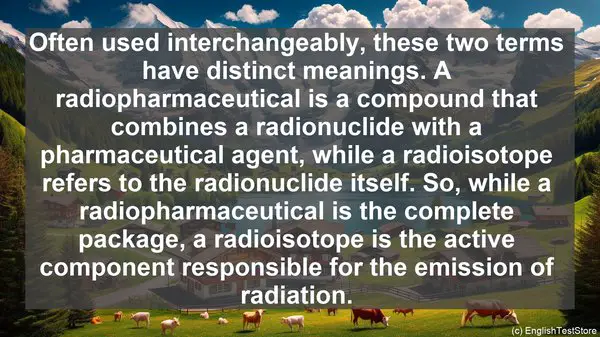Introduction
Welcome to today’s lesson on nuclear medicine. In this lesson, we’ll be discussing the top 10 commonly confused words in this field. Understanding these words correctly is crucial for accurate communication and interpretation in nuclear medicine. So, let’s dive in!
1. Radiopharmaceutical vs. Radioisotope
Often used interchangeably, these two terms have distinct meanings. A radiopharmaceutical is a compound that combines a radionuclide with a pharmaceutical agent, while a radioisotope refers to the radionuclide itself. So, while a radiopharmaceutical is the complete package, a radioisotope is the active component responsible for the emission of radiation.
2. SPECT vs. PET
Both SPECT (Single-Photon Emission Computed Tomography) and PET (Positron Emission Tomography) are imaging techniques used in nuclear medicine. However, they differ in the type of radiation detected. SPECT uses gamma rays, while PET detects positrons. This dissimilarity in radiation type leads to variations in the clinical applications and image quality of these two techniques.

3. Half-Life vs. Decay Constant
When discussing the radioactive decay of a substance, the terms half-life and decay constant often come up. The half-life refers to the time it takes for half of the radioactive atoms in a sample to decay, while the decay constant represents the probability of decay per unit time. While the half-life provides information about the rate of decay, the decay constant is a measure of the intrinsic stability of the radioactive material.
4. Scintigraphy vs. Scintillation
Scintigraphy and scintillation are related to the detection of radiation. Scintigraphy is the imaging technique that uses scintillation detectors to capture radiation emitted by a radiopharmaceutical. On the other hand, scintillation refers to the process by which a scintillation detector converts radiation energy into visible light, which is then detected and recorded.
5. Isotonic vs. Isosmotic
In the context of solutions used in nuclear medicine, isotonic and isosmotic are often used. Isotonic refers to a solution that has the same concentration of solutes as the reference solution, typically the body fluid it is intended to be administered into. Isosmotic, on the other hand, refers to a solution that has the same osmotic pressure as the reference solution. While these terms are related, they are not always interchangeable.

6. Collimator vs. Filter
Both collimators and filters are components used in nuclear medicine imaging systems. A collimator is a device that allows only radiation from a specific direction to reach the detector, thus providing spatial resolution. On the other hand, a filter is used to modify the energy spectrum of the radiation, typically by attenuating low-energy photons. While both are important for image quality, their functions differ.
7. Count Rate vs. Count Density
When discussing the measurement of radiation, count rate and count density are commonly used terms. Count rate refers to the number of radiation events detected per unit time, while count density represents the number of events per unit area. While count rate provides information about the overall activity, count density gives insight into the spatial distribution of the radiation source.
8. Attenuation vs. Scatter
In the context of radiation passing through matter, attenuation and scatter are important phenomena. Attenuation refers to the reduction in radiation intensity as it passes through a material, caused by absorption and scattering. Scatter, on the other hand, specifically refers to the change in direction of radiation due to interaction with the atoms in the material. While both contribute to the overall interaction, they have distinct characteristics.
9. ROI vs. VOI
ROI (Region of Interest) and VOI (Volume of Interest) are terms used in image analysis. ROI refers to a specific area or region within an image that is selected for further analysis. VOI, on the other hand, refers to a three-dimensional volume within an image. While ROI is typically used in two-dimensional analysis, VOI is more relevant in three-dimensional studies.
10. MIRD vs. OLINDA
MIRD (Medical Internal Radiation Dose) and OLINDA (Organ Level Internal Dose Assessment) are dosimetry models used in nuclear medicine. MIRD provides a standardized approach to estimate radiation doses to organs and tissues, while OLINDA is a software tool that incorporates the MIRD methodology for specific radiopharmaceuticals. Both are valuable resources in radiation dosimetry.
